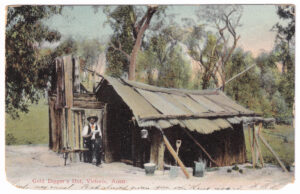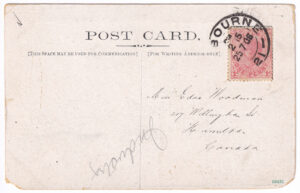[Editor: This postcard, which incorporates a photograph of a gold digger’s hut, or shack, is postmarked 25 July 1906.]
[Front of postcard]
Gold digger’s hut, Victoria, Austr.
[Handwritten text, in italics]
Thanks very much.
Had almost given you up.
Kind regards
K H R
[Description: A photograph of a gold digger’s hut, or shack, in the bush, with a man sitting outside, reading a document.]
[Reverse of postcard]
[Handwritten text, in italics]
[Addressed to:]
Miss Edna Woodman
217 Wellington St
Hamilton
Canada
68431
[No identifying information about the manufacturer was included on the postcard.]
Source:
Original document
Editor’s notes:
Dimensions (approximate): 140 mm. (width), 90 mm. (height).
Even though this postcard was sent after the inauguration of the Commonwealth of Australia (1901), it has a Victorian postage stamp; nationwide postage stamps were not produced until 1913, with the introduction of the “Kangaroo and Map” stamps.
Austr. = (abbreviation) Australia
[Editor: For ease of reading, the original text has been separated into paragraphs, and punctuation has been inserted as deemed appropriate.]
Updated 27 April 2023


Dear Ed.
I read the addressee’s name, as being:
Miss Edna Woodman.
If you look at the W in my “Woodman”, and compare it with the W in Wellington (on the address line immediately below it); I think that you will perceive that both of those letters are very similarly constructed.
Furthermore, if you then look one address line further down, to the name of Hamilton; it appears to me that the formation of the H is completely different from the initial letter of the surname which I am reading as Woodman.
Also, did you note the pencilled “Industry” written upside down on the address side?
I also perceive, immediately under the bottom right-hand of the postage stamp, pencilled in is “3 …”. Unsure if this might be 3d for threepence; or perhaps 3rd for third, and cannot decipher the other pencil marks nearby.
Oh, one more thing: you describe the scene as being of a man reading a newspaper. In looking deeply at what he is reading, it doesn’t seem to me to be a newspaper. Perhaps a letter or other document.
With respect as always.
Hi Raymond,
Thank you very much for your observations.
I agree with your reading of “Edna Woodman”; that name has now been changed.
The word in pencil was noticed, but was disregarded as a later addition and extraneous to the subject matter. Although, looking at it again, the handwriting seems older in style, and may have been contemporaneous. As many people collected postcards in that era, perhaps it was sorted into the “Industry” section of someone’s collection? (In terms of gold digging being an industry.)
I had not noticed the “3” below the postage stamp. It might even be “3rd”? There are some other pencil markings to the right and underneath of the “3”, which are hard to make out; they may be later additions (although, like “Industry”, possibly contemporaneous).
I think you are right about the paper the man is holding. Looking at it again, I see that it is smaller than a broadsheet, which was the size of most newspapers in those days. It might be a handbill, or perhaps a legal foolscap document. The word “newspaper” has now been changed to “document”.
Thank you once again for your eagle-eyed assistance.
Regards, Ed
(The once great soaring eagle of postcard descriptions, now the barnyard chicken of the same, humbled by your astute observations and corrections.)
My Dear Ed.
Thank you for yet again providing kind responses to my suggestions.
You are still the soaring eagle, my dear Sir!
It is very easy for us lesser mortals, or barnyard chickens, to carp (cheep?) about minor issues, after you have committed so much time and effort to provide the wonderful major transcriptions and explanations etc. to each card.